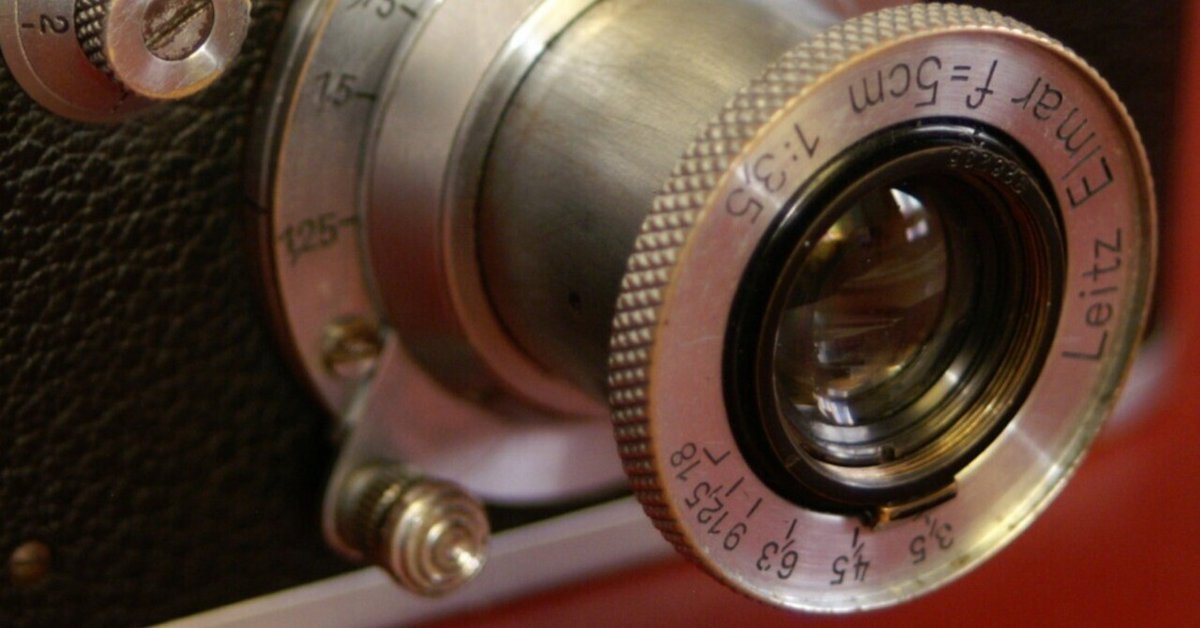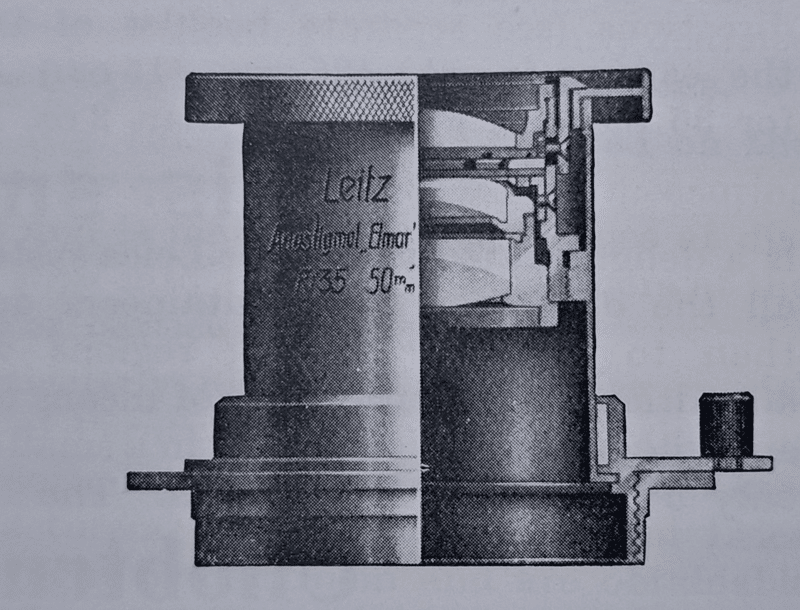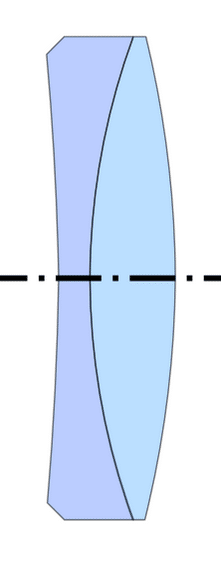
Elmar 5cm F/3.5はTessarタイプなのか?
皆さんこんにちは、うにょーん(@dictator_unyoon)です。さて今回はタイトルの通り、Ernst Leitzを代表するレンズにして「標準レンズ」の始祖たるElmar 5cm F/3.5のレンズ構成に関するお話です。
Elmar 5cm F/3.5はTessarタイプなのか?
Elmar 5cmのレンズ構成について、多くのWebサイトや書籍が「Tessarタイプ」だと紹介しています。確かに、構成図を見るとぱっと見の構成はZeiss社のTessarと類似する点があります。しかし、実際にElmarを使用してみると、これは本当にTessarなのか?と違和感を覚えたのです。空気感、質感描写、ボケ具合。どれもTessarとは違うではありませんか。
決定的なのはErnst Leiz公式パンフレットの表記です。

Elmar 5cm F/3.5はTriplet、Ernst Leitzはそう書いているのです。
こうなっては居ても立っても居られません。当時の資料や特許データを参考にこの問題に答えをだしてみましょう。
まずはTripletとTessarを詳しく見ていきましょう
Triplet

By Mliu92 https://onl.bz/pLVT6xS
ここに、私、ハロルド・デニーズ・テイラー(HAROLD DENNIS TAYLOR
)、イギリス女王の臣民で、イングランド王国、ヨーク郡のヨークに住む者が、レンズに関して新たに有用な改良を発明しました。以下はその仕様です。
このレンズが革新的であった点は像面湾曲の補正にあります。19世紀後半のレンズ設計は色消しレンズを組み合わせることで高画質を得ることを目的としているものでした。つまり、色消しレンズを何枚も組み合わせることで各収差の補正を狙ったのです。
しかし、この方法で設計されたレンズには大きな像面湾曲が発生してしまいます。対物レンズは基本的に凸レンズであるという特性があるのですが、凸レンズのみで設計された光学ではレンズの中心を通る光と周辺部を通る光とが上手く結像する事が出来ず、結果的に中心部と周辺部でピントがズレてしまいます。これは風景用レンズなどでは致命的な欠点となりえるものです。
では凹レンズを追加しよう!といってもそう簡単な話ではありません。無暗に凹レンズを増やすことは色消しレンズの効果を阻害するだけではなく、新たな収差を生みかねないからです。色消しと像面湾曲の補正の両立をしなければならないという難問に、当時の設計者は直面していました。

I get over these difficulties by the simple device of dividing my positive lens into two portions and placing my negative corrector lens be,- tween them, thus forming a triple combination. The above principle of corrections re mains equally in force, as may be gathered from Fig.3, which roughly represents such a triplet lens having its two positive lenses L and L alike in power and shape, but turned in opposite directions.
この問題を最初に解決したのがTripletタイプなのです。光学レンズには「エレメント同士の幅が広がると補正により強いパワーのレンズが必要になる」という法則があります。この法則を利用して、一群目と二群目に凸レンズ、長い距離を置いて三群目に強い凹レンズを配置する事で色消しと像面湾曲の補正、その両方を達成することが出来たのです。これは光学史に残る快挙でした。
しかし、テイラー氏は特許文の中で、このレンズタイプには改良の余地がある事を綴っています。
Having explained as best I can the main principle on which all the lenses described in this specification are based,I should point out that the substantial thicknesses of the lenses,and more especially of the front it necessary to accuracy in estimating their focal powers to make a small reduction for the thickness.
それはTripletタイプは使用しているレンズが厚すぎるというものでした。実の所、Tripletタイプは像面湾曲をこれまでにないレベルで補正してはいたものの完璧ではありませんでした。厚く屈折率の高いレンズを多用する事は、製造時に扱いづらいだけではなく、別の収差の原因にもなりえますし、レンズ構成の発展(高性能化や広角化など)を阻害してしまいます。
Should glasses of still higher refractive power become available in the future for the positive lenses in conjunction with glasses of still lower ref refractive power for the negative lenses, then a further relaxation of the relative power of the negative lens may become possible, leading to still further improvement.
余談ですが、テイラー氏はより高性能の硝材が開発されればより高度な収差の補正が可能であると綴っています。これは後に数々の名玉が証明しましたね。
Tessar

By Mliu92 https://onl.bz/88DWVhd
私、パウル・ルドルフ(PAUL RUDOLPH)、博士、ザクセン=アルテンブルク公国の臣民であり、ドイツ帝国、ザクセン=ヴァイマル大公国のイェーナ、カール・ツァイス通りに住む者は、新しいかつ有用な写真用対物レンズを発明しました。以下にその仕様を示します。
「色消しと像面湾曲補正の両立」というTripletタイプが成した偉業。これをTripletタイプの次に達成したのがルドルフ博士のTessarタイプです。
The objective described in Patent No. 444,714 and the objective described in Patent No. 660,202 may be considered to have been combined in the present objective. The objective of Patent No. 444,714 is restricted to two groups of cemented lenses separated by the diaphragm, and the opposite effects by which astigmatic correction is obtained are derived solely from the refractive action of cemented surfaces. In the objective of Patent No. 660,202 the said correction is based on the opposite powers of two pairs of facing surfaces, each group of lenses having an airspace between its components. In the new objective the opposite effects producing astigmatic correction are obtained by giving to the power of the cemented surface of the group of lenses in contact the opposite sign to that of the power of the pair of facing surfaces presented by the other group of lenses.
このレンズは同じくルドルフ博士が開発したUnarとProtarを組み合わせて設計されました。このレンズの設計の妙は絞りを中心として前後を対象に設計した事です。
First, a negative cemented surface may be employed, together with a positive pair of facing surfaces, and, secondly, a positive cemented surface with a negative pair of facing surfaces. The first combination leads to a less favorable result; but the second combination, which embodies the present invention, is fruitful in an extraordinary degree. A cemented surface at one side of the diaphragm and a pair of facing surfaces at the other side are well known in objectives, which consist of four components arranged in two groups; but hitherto the power of the cemented surface possessed the same sign as the power of the pair of facing surfaces. In the Petzval objective both have dispersive effect, and the same obtains in Steinheils portraiture antiplanet. The example of the improved objectiveshown in the drawing is described below by exact data as to radii, thicknesses, diaphragm intervals, and glasses employed.
Tessarは、3群4枚の構成で、各郡には2枚のレンズで構成しています。前群には色消しレンズがあり、後群には貼り合わせレンズがあります。群単独では前群は正のパワーを持ち、後群は負のパワーを持ちます。
TessarがTripletより優れた光学性能を有するとされる所以は光学が対称で、かつ凸凹凹凸と工夫された配置の設計となっている点です。この対称構造を維持することによって収差を完璧に補正出来ます。無論、像面湾曲の補正と両立しながらです。
また、極端にパワーの強いレンズを用いることなく後群の貼り合わせレンズを用いて像面湾曲を補正する事でレンズにさらなる発展性を持たせました。このレンズが後にどのように発展したかは…こんな場末のnoteを読んでいる方には説明不要でしょう。
Elmarはどんなレンズなんでしょうか

By Mliu92 https://onl.bz/d1As4Z9
このレンズは、収差を補正した画像面の形成を行うために3群で構成されています。1群は凸レンズで2群は凹レンズ、3群は貼り合わせられた2枚のレンズから成り立っています。
ここではっきりとしておきたいことがあります。それはElmarは非対称型のレンズ構成であるということです
Unsymmetrisches Objektiv. Die bisher bekannten unsymmetrischen Objektive mit anastigmatischer Bildfeldebnung aus drei Gliedern, von denen das erste eine Sammellinse, das zweite eine Zerstreuungslinse ist und das letzte Glied aus zwei miteinander verkitteten Linsen besteht, verwenden im dritten Glied eine verhältnismäßig stark gekrümmte Kittfläche. Abgesehen von den technischen Nachteilen bei der Herstellung wird bei gegebener Dicke der einen Linse auch ihre freie Öffnung durch die starke Krümmung der Kittfläche beschränkt.
非対称型レンズ。今日までに知られているアナスティグマット性能を備えるトリプレットタイプのレンズは3群3枚構成でしたが、このレンズは収差の補正を行うために3群4枚で構成されており、このうち1群は凸レンズ、2群は凹レンズ、3群は2枚のレンズを貼り合わせた構造です。これらのレンズのうち、3群では比較的強く湾曲した貼り合わせレンズが使用されています。この設計において、開放F値は製造時における技術的制約とは別に貼り合わせレンズの強い湾曲によっても制限されます。。

The "Elmar" Anastigmatic F/3.5 Lens 5cm. focus,introduced by us has been specially computed for the Leica camera.It is composed of a dis-symmetrical triplet with a cemented back lens and is corrected in a very high degree within an image field of 48°. It is entirely free from coma and curvature of the image, and does not exhibit any appreciable degree of zonal astigmatism or the slightest degree of distortion.
このことを考えると、Elmarを対称構造がその設計の妙であるTessarタイプと位置付ける事は不自然であることは明白でしょう。
やはり、Leitz社が特許やパンフレットに記載している様に、ElmarはTripletタイプとするのが妥当だと思います。
なぜ、Tessar?
ElmarはTripletタイプ、そうパンフレットに記載されており、光学図も確かに非対称。なのに、多くの文献でElmarはTessarタイプだと間違った知識が紹介されているのはなぜでしょうか。
光学に関与した経験のある方や、カメラ業界に長く身を置いている方が「ぱっと見の構成が似ている」だとか「あの本に書いてあった」そんな簡単な理由でこの間違った知識を書き広めたとは考えづらいです。
実は、この謎を解くの一つの鍵になりゆる事実があります。

Leitz anastigmat5cm F/3.5又はElmax 5cm F/3.5と呼ばれているレンズの構成図です。
後群が3枚の貼り合わせレンズになっているのが特徴となっています。
…肝心なところで画像が用意出来ず申し訳ない。二次利用可能な構成図が見つかりませんでした。
Elmarの前身であるLeitz anastigmat5cm F3.5/Elmax 5cm F3.5と名付けられたレンズの光学には後群に特徴的な三枚の貼り合わせレンズがあります。なぜこのようなお金と手間が掛かる設計になっているのでしょうか。これには理由があります。それは、Tessarの特許回避というものです。
What I claim as my invention, and desire to secure by Letters Patent, is- A spherically, chromatically and astigmatically corrected objective, consisting of four lenses separated by the diaphragm into two groups each of two lenses, of which groups one includes a pair of facing surfaces and the other a cemented surface, the power of the pair of facing surfaces being negative and that of the cemented surface positive. In testimony whereof I have signed my name to this specification in the presence of two subscribing witnesses. PAUL RUDOLPH.
ドイツで提出されたTessar特許の米国版、US Patent 721240ではアナスティグマットレンズで、絞りがあり、4枚のエレメントの内二枚ずつの色消しレンズと貼り合わせレンズを持ち、前者が正のパワー、後者が負のパワーを持つ構成を保護しています。
つまりElmarの3群目が

By Mliu92 https://onl.bz/d1As4Z9
Tessarの3群目の特許を侵害してしまうのです。

By Mliu92 https://onl.bz/88DWVhd
これを回避するために当時のErnst Leitzは三枚貼り合わせなんていうコストも手間もかかる方法を利用していたのです。
繰り返しますが、Leitz anastigmatの様に三枚の貼り合わせレンズを拵える事は手間もコストも掛かります。そこでTessarの特許切れを待ってから3群目をTessarと同じく2枚の貼り合わせレンズと改めました。これがElmarです。
Tessarの特許が切れるのは1920年。Elmar発表も1920年。結構露骨ですね。

1920年2月24日に特許の保護が切れる
このような事情が、当時日本国内で盛んな論争が行われた火の粉飛ぶLeica-Contax論争(戦時中になにやってんだ)でElmarはTessarなんだとContax信者に曲解されたり、Elmarの構成をTessarが真似たんだとLeica信者が妄言を吐いたりしているうちに滅茶苦茶になった結果、現在のElmarはTessarタイプという話が広まったのだと思います。
また、SNSが広まった昨今においては、レンズ構成図を軽く見たインフルエンサーが適当にElmarはTessarだとか言いふらしたのも原因だとは思います。
まとめ
Elmar 5cm F/3.5はTripletタイプ!!!!!
今日は皆さんこれだけ覚えて帰って下さいね。
しかし、こうレンズについて色々書いているとレンズが欲しくなりますな。とはいえ学生故お手軽なオールドレンズであってもnoteの為だけに買うなんてことは出来ませんが…無限の財力が欲しい(人類共通の夢)
以上、うにょーんでした。
